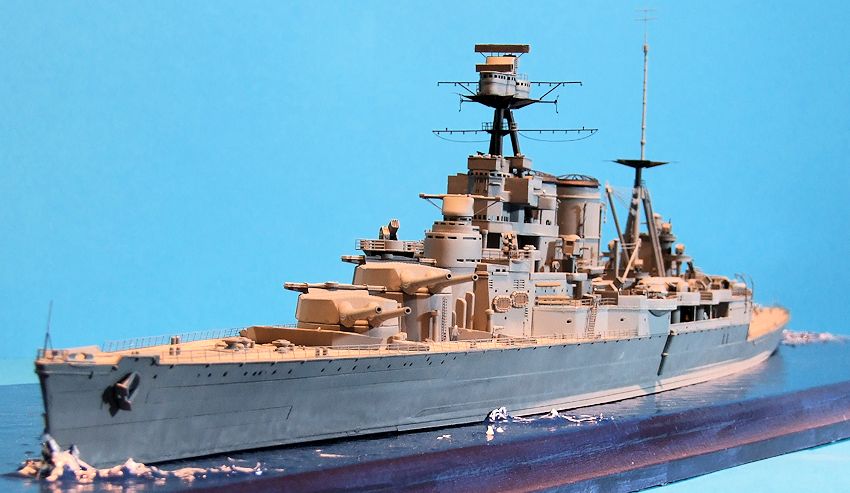
Trumpter 1/350 HMS Hood
| KIT #: | 5302 |
| PRICE: | $130.00 |
| DECALS: | one option |
| REVIEWER: | Dale Rannals |
| NOTES: |
Upgrades:
Hunter Wood deck #W35027
Flyhawk resin turret set #FH350099
Eduard PE Detail set #EDU53020
Tamiya Figure set #12622
Trumpeter's Hood Brass Upgrade Set
#06601 |

| HISTORY |
I could tell you a story.
A story repeated so many times, and therefore accepted as gospel, of how
HMS Hood, last of the British battlecruisers, was destroyed by Germany's
battleship Bismarck. Of how one of
Bismarcks 15” shells came crashing vertically down and penetrated through Hood's
very thin deck armor (because battlecruisers sacrificed armor for speed) and
detonated inside her magazines, destroying the ship in a matter of minutes.
I could do this, but I'm not going to.
We're going to look at things a little differently and maybe shed some
light on things.
 First, the battlecruiser, or large armored cruiser.
A creation of Jackie Fisher, these greyhounds of the sea would hunt down
marauding enemy cruisers with their superior speed, and with their superior
armament destroy them easily. To
have these attributes armor was on the light side, but this made no difference
to Fisher, to whom “speed is armor.”
Realistically, the ships would only need to be armored against cruiser
fire, and during the Battle of the Falklands of WW1 the concept was vindicated.
Here the battlecruisers HMS Invincible and HMS Inflexible pursued and
destroyed the German cruisers Scharnhorst and Gneisenau.
It was not a one-sided fight by any means, as the fire from the German
cruisers was very accurate and they fought gallantly to the end, but that end
was never really in doubt.
First, the battlecruiser, or large armored cruiser.
A creation of Jackie Fisher, these greyhounds of the sea would hunt down
marauding enemy cruisers with their superior speed, and with their superior
armament destroy them easily. To
have these attributes armor was on the light side, but this made no difference
to Fisher, to whom “speed is armor.”
Realistically, the ships would only need to be armored against cruiser
fire, and during the Battle of the Falklands of WW1 the concept was vindicated.
Here the battlecruisers HMS Invincible and HMS Inflexible pursued and
destroyed the German cruisers Scharnhorst and Gneisenau.
It was not a one-sided fight by any means, as the fire from the German
cruisers was very accurate and they fought gallantly to the end, but that end
was never really in doubt.
Of course, that was the ideal circumstance for the type.
But in wartime, circumstances are rarely ideal.
With battleship size and battleship guns and great speed, it was
inevitable that they would be put in the battle line.
Though it was a situation they were never designed for, that is exactly
where they ended up. The
battlecruisers became a “fast scouting wing” of the battle fleet, and would soon
be facing enemy battlecruiser and battleships, ie, ships with the same big guns.
Here the light armor would tell, and at the Battle of Jutland the
explosive demise of three British battlecruisers, with an accompanying huge loss
of life, showed them to be, well.....not necessarily a flawed type, but a
fundamentally flawed implementation of the type.
As a side note, some evidence points to the fact that the explosions that
destroyed the British ships could have been caused by anti-flash safety
interlocks being disabled (rather than outright magazine penetrating from lack
of armor.) This seemed to have been done to get the maximum rate of fire
possible, but the side effects of flash from a turret-penetrating hit
propagating down (through open interlocks) to the magazines could, and did, have
catastrophic results. Now the
German battlecruisers took an absolute pounding from the British ships during
the battle, losing only one, hours later, from flooding from all the damage
absorbed. But the Germans also used
a different philosophy than the British.
They designed their battlecruisers with slightly less speed and smaller
main guns, but much better armor than their British counterparts.
So most of them survived the battering they received … barely, but
survived nonetheless.
On the very day these two great fleets met and such life was lost, a huge ship
was laid down at John Brown Shipyards on the Clyde River.
She was HMS Hood, or to the shipyard workers there, simply “The Monster.”
She started life out as a shallow draught battleship.
As the British were superior in numbers in battleships, the design was
changed to a 15” gunned battlecruiser to counter rumored German ships building.
But in the aftermath of Jutland the build was halted, and the design
completely scrutinized and revised.
What emerged from this was much more a fast battleship than a battlecruiser.
Compared to the much vaunted Queen Elizabeth super-dreadnoughts, she had
just as much deck armor and a more e ffective belt (1' thinner but angled), the
same main armament (with 30 degree elevation instead of the QE's 20) and around
8 knots more speed. She was, in
effect, a larger, faster Queen Elizabeth.
This was just before the British went to the all-or-nothing armoring
(where components have the thickest possible armor or none at all), so
the deck armor was divided into several deck layers. But all in all she had a
very comprehensive armor scheme, and total displacement devoted to armor
protection was around 33%, much higher than the previous battlecruisers and more
in line with German battlecruisers
….. and battleships in general.
(For some actual numbers: Hood,
32.7% Queen Elizabeth, 31.3%
Renown,18.1% Moltke,
33.3% Nagato, 30.8%)
She was the largest, fasted capital ship in the world …. a title she
would keep for some two decades.
ffective belt (1' thinner but angled), the
same main armament (with 30 degree elevation instead of the QE's 20) and around
8 knots more speed. She was, in
effect, a larger, faster Queen Elizabeth.
This was just before the British went to the all-or-nothing armoring
(where components have the thickest possible armor or none at all), so
the deck armor was divided into several deck layers. But all in all she had a
very comprehensive armor scheme, and total displacement devoted to armor
protection was around 33%, much higher than the previous battlecruisers and more
in line with German battlecruisers
….. and battleships in general.
(For some actual numbers: Hood,
32.7% Queen Elizabeth, 31.3%
Renown,18.1% Moltke,
33.3% Nagato, 30.8%)
She was the largest, fasted capital ship in the world …. a title she
would keep for some two decades.
But time does move on. The
Admiralty realized that Hood's deck armor was insufficient to withstand modern
long range battles with plunging shells
…... as was all of their
remaining WW1 era battlecruisers and
battleships. A
reconstruction/refit program was put into effect to try to remedy the situation,
but as Hood was by far the most modern and useful warship of the group, she was
quite far down on the list. A major
refit was planned in 1942, but by then WW2 had broken out and Hood would have
been too valuable to be taken out of service to have the upgrades done.
So on May 24, 1941, Admiral Holland went into battle aboard Hood knowing full
well her deficiencies. When
Bismarck was sighted, he knew he had to close the range to a point where the
dangers from plunging fire were minimized and side armor, where Hood and
Bismarck were equals (with the edge going arguably to Hood with her angled belt)
came into effect. This closure meant their “A” arcs were not open, ie, the aft
turrets could not fire, but it was the fastest way to close the range. Some have
described Holland's tactics as “ill-fated”, but it was a standard doctrine of
battle. It was only ill-fated
looking at the results. (Admiral
Tovey, upon finding Bismarck several days later, also took an end-on approach to
close range while having two of the most heavily armored battleships in the
world.)
So Holland closed the range and at around 18000 yards (sources vary) started a
20 degree turn to port. HMS Hood
had a very complex armor scheme, as was noted, so calculating an immune zone is
difficult. But at this range the
elevation of Bismarcks guns dictated a shell impact angle of around 10 – 15
degrees. This is far more side/belt hits than deck penetrations and a far cry
from the “vertically plunging” fire often described.
The 20 degree turn to port was to open up the “A” arcs and get the after
turrets into the battle. At that
point there would be 18 heavy guns against Bismarcks 8.
But it was not to be.
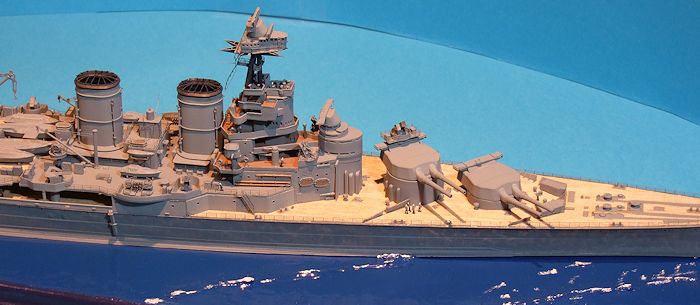 Bismarcks fire was marvelously accurate from the beginning, and it was here that
a shell from Bismarcks fifth salvo found it's way into Hood.
It is very plausible it could have landed short and gone under the belt
(German shells, just by chance, had very good underwater performance.)
Outright penetration of the 12” belt would have been problematic, given
the shell angle of fall combined with the 10 degree inclination of the belt ….
German range and penetration charts show this.
(Even if it did, it's exit velocity would be reduced to the point that
the shells fuse delay would not let it get very far before exploding anyway....
certainly not enough to reliably reach a magazine.)
It could have gone over the main 12' belt, through the 7” or 5” section
above (though, again, the shells reduced exit velocity and normalization meant
Hood's “thin” deck armor behind this was about the perfect thickness to deflect
shells at this range), or it could have just found that vulnerable deathstar-vent
….. that unknown path to the vitals that any ship can have.
An extremely lucky shot, no matter what path it took … and in combat,
well, luck works. (This is not an
attempt to de-value Bismarcks shooting.
Hitting Hood showed fantastic shooting; hitting Hood in a spot that could
destroy her is luck.) Whatever the
path …... and no one will ever know for sure …..
the shell found its way into the after magazines containing a bit over a
hundred tons of cordite. What
happened next is called a conflagration, a sort of slow explosion if you will.
The cordite started burning. As pressure built up it burned more
intensely, building even more pressure quicker.
Once high enough, this burn took the path of least resistance, blowing
out the forward bulkheads into the engineering spaces and up through the
engine-room vents. To an observer,
it would look like spectacular jets of flame around the base of the mainmast.
This would temporarily relive the pressure, but only temporarily.
It would not be enough to prevent this area of the ship from being
utterly destroyed. From time of
penetration to there being nothing left of center section of the ship was only a
second or two.
Bismarcks fire was marvelously accurate from the beginning, and it was here that
a shell from Bismarcks fifth salvo found it's way into Hood.
It is very plausible it could have landed short and gone under the belt
(German shells, just by chance, had very good underwater performance.)
Outright penetration of the 12” belt would have been problematic, given
the shell angle of fall combined with the 10 degree inclination of the belt ….
German range and penetration charts show this.
(Even if it did, it's exit velocity would be reduced to the point that
the shells fuse delay would not let it get very far before exploding anyway....
certainly not enough to reliably reach a magazine.)
It could have gone over the main 12' belt, through the 7” or 5” section
above (though, again, the shells reduced exit velocity and normalization meant
Hood's “thin” deck armor behind this was about the perfect thickness to deflect
shells at this range), or it could have just found that vulnerable deathstar-vent
….. that unknown path to the vitals that any ship can have.
An extremely lucky shot, no matter what path it took … and in combat,
well, luck works. (This is not an
attempt to de-value Bismarcks shooting.
Hitting Hood showed fantastic shooting; hitting Hood in a spot that could
destroy her is luck.) Whatever the
path …... and no one will ever know for sure …..
the shell found its way into the after magazines containing a bit over a
hundred tons of cordite. What
happened next is called a conflagration, a sort of slow explosion if you will.
The cordite started burning. As pressure built up it burned more
intensely, building even more pressure quicker.
Once high enough, this burn took the path of least resistance, blowing
out the forward bulkheads into the engineering spaces and up through the
engine-room vents. To an observer,
it would look like spectacular jets of flame around the base of the mainmast.
This would temporarily relive the pressure, but only temporarily.
It would not be enough to prevent this area of the ship from being
utterly destroyed. From time of
penetration to there being nothing left of center section of the ship was only a
second or two.
The aft portion of the ship …. what was left of it … quickly sank beneath the
waves. The forward section
continued forward for a short few moments before planing up vertically and
sliding down beneath the surface.
Out of 1400 men, only three survived.
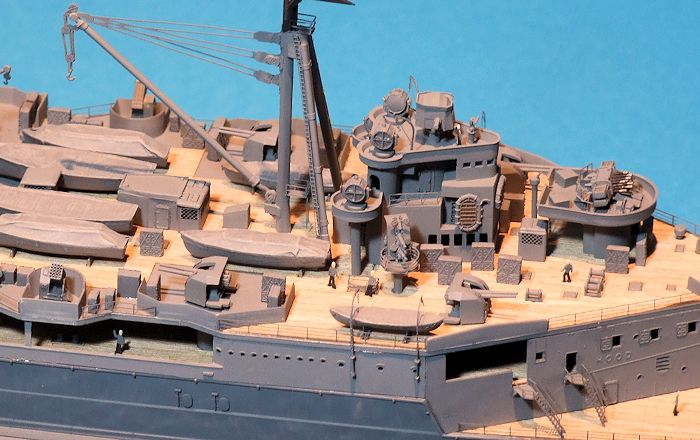 A very proud ship, one that embodied the Royal Navy, was gone.
Many in Britain claim they received no bigger shock during the war than
when they heard the news. The
German crews were of course joyous of their victory over the “Mighty Hood.”
But her sinking underscored the fact to many of them that no ship is
unsinkable …. even their own. It
was a fact they would experience in a scant three days.
A very proud ship, one that embodied the Royal Navy, was gone.
Many in Britain claim they received no bigger shock during the war than
when they heard the news. The
German crews were of course joyous of their victory over the “Mighty Hood.”
But her sinking underscored the fact to many of them that no ship is
unsinkable …. even their own. It
was a fact they would experience in a scant three days.
The rest of the story can be found elsewhere and can be found in great detail.
I wanted to concentrate on the myths of Hoods protection.
She was a very advanced World War One design and was the worlds first
true “fast battleship.” Her
protection was not up to post-war standards, as were none of Britain’s WW1
Battleships.
Her deficiencies were not the
result of a poor design, just of the standards of war moving on.
Her biggest problem was, as Lord Chatfield said in The Times, that “she
had to fight a ship 20 years newer than herself.”
| THE KIT |
When I was a young …. er, younger …. lad I got for
a birthday Lindberg's 1/400 scale HMS Hood.
I knew nothing about the ship but it looked cool, like a battleship
should. It was motorized and the
turrets turned and it floated and did figure-eights in the water and ….. yeah,
it was really cool. Never mind that
as that young lad I didn't realize how horrid that kit actually was.
I just had hours of fun cruising her around the local pond fighting off
the imaginary enemy fleet. A few
years later, in high school, I came across a library book called “Pursuit” by
Ludovich Kennedy about the Bismarck chase.
Here is where I first learned the history of Hood and I have been hooked
ever since. Since that time I have
accumulated 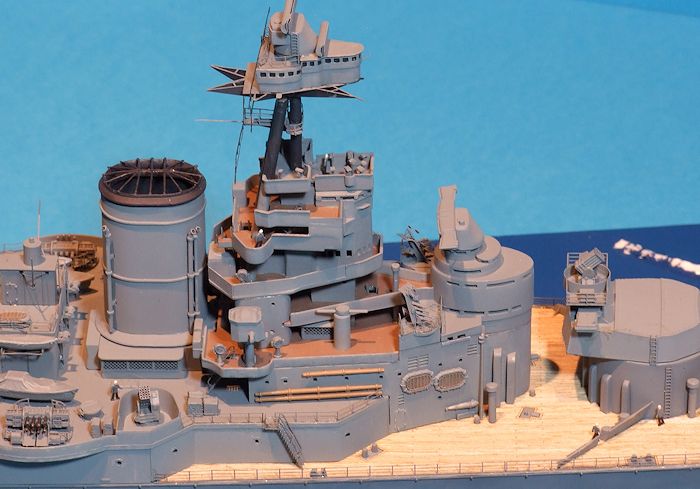 many books on Hood, and the whole Bismarck chase, from many
viewpoints. In 1982 I built, and
still have, a Testors 1/720 Hood.
It is a fantastic kit with great detail and still holds up today.
A decade ago or so there were a couple of gorgeous 1/350 resin models of
Hood. I almost spent the $500, but
in the end just could not justify it.
Well, good things apparently do come to those who wait, for Trumpeter
came to the rescue. Trumpeter
worked with the HMS Hood Association to get the kit as right as possible, and
they did a pretty good job. There
are areas that are not quite right, but a very presentable model can be built
right out of the box.
many books on Hood, and the whole Bismarck chase, from many
viewpoints. In 1982 I built, and
still have, a Testors 1/720 Hood.
It is a fantastic kit with great detail and still holds up today.
A decade ago or so there were a couple of gorgeous 1/350 resin models of
Hood. I almost spent the $500, but
in the end just could not justify it.
Well, good things apparently do come to those who wait, for Trumpeter
came to the rescue. Trumpeter
worked with the HMS Hood Association to get the kit as right as possible, and
they did a pretty good job. There
are areas that are not quite right, but a very presentable model can be built
right out of the box.
Trumpeters Hood contains 533
pieces of gray plastic in a nice big sturdy box. Most of the molding is nice,
but many parts in my kits exhibited flash and prominent seams. A ship stand in
black plastic is included for the full hull builds.
A small brass PE fret is also in the box.
Instructions come in a 20 page book.
A very nice two page fold-out full color painting guide is included;
colors depicted in
Gunze-Sangyo colors.
| CONSTRUCTION |
As there are several reviews of Trumpys Hood on the site already, I decided
that, rather than go thru everything in the build, to just highlight the areas
that I did differently or changed substantially.
I referred to H.M.S. Hood Associations site often during the build …
there is a section dedicated to Trumpeters 1/350 Hood and what needs changed.
I also very frequently looked at the Kagero HMS Hood book of their “Superdrawings
in
3D” line.
This has invaluable renderings at fantastic angles of all areas of the
ship.
-
Hull: Trumpeter modeled Hood's hull
plating rather heavy-handedly. There are deep troughs at the bow and stern that
are completely out of scale in trying to replicate plating. It almost looks like
there are parts of the hull missing. This is one of the first things I spotted
upon opening the box for the first time, and I was quite disheartened by it.
Hoods hull does not look like this.
This is also the very first thing I tackled in this build.
I measured the depressions in the hull and cut pieces of thin plastic
card to fit each one. The card was
the same thickness as the holes and so lie flush with the hull surface.
I did not fill in the “seams” at all so it gives the look of plating much
better than original.
-
Deck: Painting the deck and tryi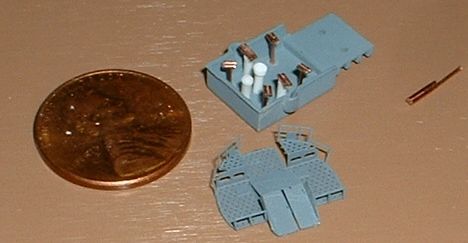 ng
to get some sort of wood detail look is not a favorite task of mine. So I bought
a Wood Hunter wood deck for the kit. I wasn't sure of what to expect, but now I
realize that this is probably the best $25 I have ever spent on an accessory.
It is paper thin, laser cut for the kit, and, except for one small bit I
had to trim, fits great. It's also
self-adhesive and so far, it has remained in place.
Finally, it just looks amazing.
Get one for sure.
ng
to get some sort of wood detail look is not a favorite task of mine. So I bought
a Wood Hunter wood deck for the kit. I wasn't sure of what to expect, but now I
realize that this is probably the best $25 I have ever spent on an accessory.
It is paper thin, laser cut for the kit, and, except for one small bit I
had to trim, fits great. It's also
self-adhesive and so far, it has remained in place.
Finally, it just looks amazing.
Get one for sure.
-
Main Turrets: These are too angular
and the roof detail is all wrong (Trumpeter mistook lapped plates for
depressions, so the roofs have good rivet detail surrounding depressed areas).
Flyhawk resin turrets rectify this and also come with a gorgeous PE
Unrotated Projectile (UP)
mount for B turret and resin UP rocket launchers.
I also bought Trumpeters detail set with the kit, and it includes brass
barrels for the main [and secondary] weapons.
Unfortunately, Trumpys barrels (with blast bags) do not fit the Flyhawk
turrets. I eventually figured out
that I could pull the Trumpeter barrels out of the blast bags....... they are a
press fit. Then, after drilling out
holes in Flyhawks blast bags to an appropriate size, glue in the Trumpeter
barrels. Sounds convoluted, but it
actually worked out pretty well.
-
Conning Tower: This is an area that
just doesn't look right. Hoods
conning tower was a big, heavily armored, and somewhat anachronistic structure.
It is also a very prominent feature of the ship.
Whereas Hoods vision slits were all uniform height, the kits vision slits
are not. Noticeably, the top row
looks more like windows. Not too
hard to fix though. I glued in
sections of thin plastic card into the top of each slit.
Once dry, I trimmed and sanded each smooth.
A little surfacer and sanding, and things look much better.
-
Ready Use Lockers: Hood had a bunch of ready use lockers. Several dozen of them.
Each one of these small pieces of the kit has a nice deep ejector pin
mark on the back. I filled each of
these with putty (or super glue … I tried several things) and sanded smooth.
I also used Eduards PE locker fronts for each, though I don’t think it
added much overall. In retrospect,
I would just go with the kit part as is (no PE) and maybe glue thin plastic card
on the back of each to cover the ejector pin marks, and sand the edges smooth.
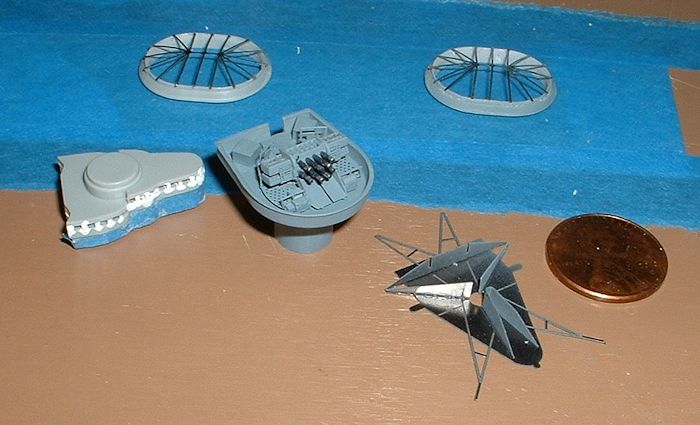
-
Ships boats: Here I sorta cheated.
Didn't feel like painting them all but I was in luck.
I was depicting the ship at sea, and at sea the boats are canvas covered.
I draped cigarette paper covered in white glue over the boats, then
trimmed each when dry. I painted
them the ships color, which is correct, but I recommend a slightly lighter or
darker shade to give things some contrast .
Mine blended in too well, but a little dry-brushing with a lighter shade
made them stand out nicely.
-
Funnels gratings: Simply put, I cut
out the center of the funnel caps and used Eduards PE gratings for each.
Sounds simple, but each one took a couple of hours to do satisfactorily.
It really adds to the overall look though.
-
Air defense station. Another
prominent area filled with ….. nothing.
In reality it was a visually busy area, with a couple center stations and
many binocular stands. I used
Plastic rod for the larger center post stations.
I replicated the binoculars by gluing two thin pieces of copper wire
together and then cutting it into lengths about the right size.
Each of these I glued atop short copper wire stands.
I also cut a walkway into the forward station and modified/angled the
splinter shields to either side of this walkway.
-
Spotting top. Several modifications
here. I modified the director cap; basically removing some extra plastic,
sanding smooth, and adding a section on top.
I used Eduards PE bits for the radar, but it is flat, whereas Type 284
had a rather substantial structure behind the aerials.
I took some half round evergreen rod, cut it to length, and hollowed out
the flat side. Glued to the back of
the PE and painted, it gives it more depth.
There was a small platform at the forward starboard side of the spotting
top. I made this out of thin
plastic sheet and added some surplus railing and a ladder.
The top of the spotting top has quite an overhang on Hood.
This is not modeled at all in the kit.
Out again comes the thin plastic sheet.
I traced the outline of the part on the plastic sheet, then drew around
the outline just a little larger freehand.
I carefully cut it out, then then smoothed and beveled the edge with a
sanding stick. This was then just
glued to the spotting top. Lastly,
the spotting top windows in the kit are pretty small.....they really need to be
larger. As I thought of no way to
realistically do this, I left it alone.
| COLORS & MARKINGS |
I used Testors Model Master Royal Navy 507C paint for this build, mixed with a
little white for some scale effect.
For the black areas, here and on all my models, I used a very dark gray I mix up
with well, black with a bit of white.
Black is just too intense for the scale(s).
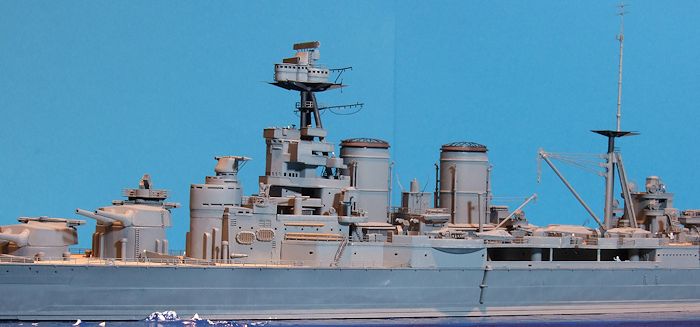 The base was made following methods from our very own Frank Spahr.
Well, I tried anyway. It
turned out pretty decent for my first try.
I stippled some old latex wall paint on the base in several applications
to get the uneven surface. Then,
using the hull bottom, I used Liquitex Gloss acrylic gel to form in a couple bow
waves. I am not a wave form expert by any means, I definitely need to study more
photos, but it looks okay. The base
was then sprayed with a dark blue from a rattle can, then some airbrushed Dark
Sea Blue to give it some variation.
I tried spraying some lighter blue along the waves but it didn't really show up.
Some titanium white oil paint was stippled along the wave crests and all around
the wake. Then many coats of high
gloss clear enamel to finish it up.
The base was made following methods from our very own Frank Spahr.
Well, I tried anyway. It
turned out pretty decent for my first try.
I stippled some old latex wall paint on the base in several applications
to get the uneven surface. Then,
using the hull bottom, I used Liquitex Gloss acrylic gel to form in a couple bow
waves. I am not a wave form expert by any means, I definitely need to study more
photos, but it looks okay. The base
was then sprayed with a dark blue from a rattle can, then some airbrushed Dark
Sea Blue to give it some variation.
I tried spraying some lighter blue along the waves but it didn't really show up.
Some titanium white oil paint was stippled along the wave crests and all around
the wake. Then many coats of high
gloss clear enamel to finish it up.
| CONCLUSIONS |
Many moons after watching that Lindberg Hood cruise around the pond, I finally
have built another large scale Hood.
This is a kit I am quite proud of, and many aspects of this build were
way outside my “comfort zone”. This
is a fantastic kit by any measure.
It has its issues, but all kits do, and most of them are easily remedied.
If you have any interest at all in the subject or even the period, I
wholeheartedly recommend this one.
| REFERENCES |
HMS Hood Association:
http://www.hmshood.com
more specifically:
http://www.hmshood.com/hoodtoday/models/trumpeter/trumpeter.htm
“The Battlecruiser HMS Hood”
Superdrawings in 3D series, Kagero 978-83-62878-78-9
“Pursuit” Ludovic Kennedy
978-0670583140
“British Battlecruisers” John Roberts 1-55750-068-1
“The Loss of HMS Hood”, Bill Jurens
http://www.warship.org/no21987.htm
“British Battleships of World War Two”, Roberts and Raven
978-0870218170
“The Battlecruiser Hood” Anatomy of the Ship series, Roberts
978-0851779003
“Battleship Design and Development” Norman Friedman 0-8317-0700-3
Dale Rannals August 2015 Thanks to If you would like your product reviewed fairly and
fairly quickly, please
contact
the editor or see other details in the
Note to
Contributors.